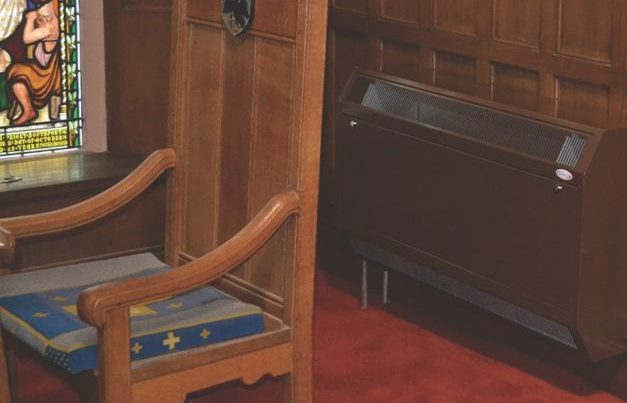Due to the specific architecture, the issue of heating a church can become a complex engineering task.
Important points in choosing heating for a church or temple:
- ceiling height in the building;
- various areas of premises (the main room of a large area, several small utility rooms);
- wide doors, high windows;
- a large number of icons, frescoes and other items of cultural and historical value that require a special temperature regime and microclimate for preservation;
- the absence of extraneous noise from the operation of electrical appliances, which will interfere with the service and the worshippers.
You can also not take into account the standard points that pay attention to when choosing a heating system – cost-effectiveness, practicality and ease of installation.
Selection of equipment for heating the church
First of all, you should consider a non-standard architecture. As a rule, a church is a fairly high building with ceilings above 4 m, a large number of icons, frescoes and painted walls.
Heating of churches and temples by convector is extremely inefficient.

- All the heat from them will rise to the ceiling, without warming the space where people are.
- It is also worth noting that convectors with forced air circulation will create air flows that will cause discomfort to parishioners, namely, they can blow out candles, create extraneous noise.
- No less important is the fact that if an icon, painting or sculpture gets in the way of the heated air from the convector, the damage caused by the temperature difference and the heat flow can be irreparable.
Heating of churches with the "Underfloor heating" system.
Installed under the floor, Underfloor heating heats only 10-15% of the room space directly above the floor. This allows you to create more or less comfortable conditions for people. However, it is difficult to consider this system as an independent type of heating due to the fact that it does not provide a sufficient level of comfortable heat.

Also, this option is not suitable for old churches, where even the floor may have artistic or architectural value. As a result, infrared panels are the most successful option.
Heating of a church or temple with infrared panels
Infrared heating is one of the most modern and profitable options for maintaining a comfortable temperature and necessary conditions in temples, churches and cathedrals. In recent years, infrared panels have been used as an independent alternative heating system not only in residential buildings and apartments. They have a completely different principle of operation. Unlike the usual heating devices, infrared panels heat what can keep the heat for a long time – the walls.

Heating with infrared panels of the convent
"The feast of the intercession" in the settlement Goscha
Advantages:
- there is no movement of air, due to which the candles are not blown out;
- energy savings due to the fact that only the necessary area is heated, and comfortable heat is stored in the room for a long time;
- do not dry the air; the panels are installed in a ready – made repair-there is no need to carry out expensive construction work;
- the presence of regulators will allow you to maintain a comfortable temperature regime;
- they work silently.
Heating of the temple with Teploceramic infrared panels
In contrast to the usual residential premises (houses or apartments), for a church, the calculation of the number of panels and the total cost of the system must be carried out strictly individually, taking into account:
- ceiling height;
- specifics of interior;
- building insulation, etc.
To date, our company has implemented more than one project in Ukraine (completed projects of Teploceramic).
Examples of successful implementation of infrared heating in religious institutions:


Escuela dominical en el pueblo de Klepachev

Sunday school in Klepachev village
- Holy Trinity Staroselsky convent in the village of Staroselye, Volyn region;
- Female monastery ""Parazdnik Pokrovsky"" Homansky in the settlement Goscha, Rivne region;
- The St. Nicholas male monastery in the village of Zhydychyn Volyn region;
- Church in the village Manevychy, Volyn region;
- The Church in the village of Diuksyn, Kostopil district, Rivne region;
- Church in the village Mirnoye, Gorokhovsky district, Volyn region;
- Church in the village Gorodok, Rivne region;
- Church in the village Dyad'kovychi, Rivne region;
- Church in the village of Danchymist, Kostopil district, Rivne region."
